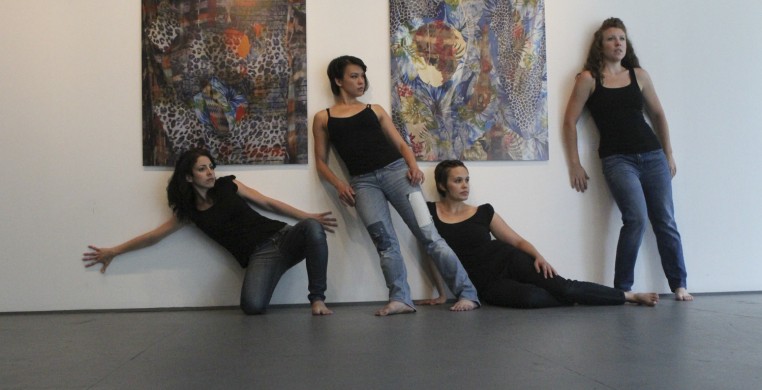By Zachary Whittenburg
Today the miracle of air travel is a semi-regular chore. Some of us occasionally opt for the thrill of diving deep into a lake, sea or ocean. A family road trip might include a day of beginner-level spelunking. For the most part, however, we humans spend our days and years on terra firma, that massive, spherical border between earth and sky.
In the words of MK Meador, HATCH Curatorial Resident at Chicago Artists Coalition, these are the "physical and psychic bookends" that demarcate our existence in space, and the subject of current HATCH exhibition "The Terrestrial, the Celestial, and the Imagined Inbetween."
Three artists' works collectively illuminate the title of the show. Ground and place are addressed by Brent Fogt's five-piece, hanging sculpture and two large canvases covered in fastidiously patterned, cut paper stained by organic processes displayed on full sheets nearby. Nicholas Sagan's wall-mounted works and installation offer both representational and conceptual gazes upward, into the cosmos. In the space between these pieces by Fogt and Sagan -- literally -- are sculptures by Noelle Allen in resin and mixed media, inspired by the earth's surface itself (more specifically, by Allen's garden in the summertime).
Enter the human body, that evolutionary miracle that invented these works, the equipment required to experience them, and the medium overwhelmingly preferred by dancemakers. The evening of Wednesday, October 16, the first installment of "Dance: A Moving Canvas" brings choreographers Jan Bartoszek, Margi Cole and nine dancers into dialogue with the exhibition, and their work into dialogue with attendees. Yours truly will have the honor of hosting this conversation; composer-musician Michael Caskey will lay sonic turf.
A gallery filled with art is not an empty stage, not a studio, and neither Bartoszek (founder and artistic director, Hedwig Dances) nor Cole (founder and artistic director, the Dance COLEctive) treat it as either in preparation. I visited both in rehearsals for "Dance: A Moving Canvas" on-site at CAC, to learn how their dances were looking to illustrate the in-between.
Noting that her dance, for seven women, couldn't rely on the fixed point of view offered by a proscenium stage, Cole said she was bearing in mind that "the details you see or don't see will depend on the viewer's location." She began with the dancers inventing solos, duets and trios. Each was identified not by name, but by a starting gesture or cue; these choreographic modules were then subjected to "slight interferences," Cole explained, "tactile impediments and obstacles. I wanted to find out, What possibilities emerge when you interrupt?" In performance, the dancers themselves will decide -- extemporaneously -- a sequence in which these components will be presented. As Cole clarified, "Basically, it's just me rubbing two things together: the dancers navigating the space, and the choreographic material." To give her dancers "something in the background while they work," Cole played songs by Lorde and Neko Case out of portable speakers plugged into her iPhone.
Bartoszek and two dancers, Jessie Gutierrez and Edson Cabrera, took most of the following day to "sketch the outline" of a duet staged alongside the west and north walls of the gallery, likewise using "working music" to lend shape and texture to the choreography. Purcell's "O Let Me Weep, For Ever Weep" decorated the air while the pair negotiated one of Allen's spherical floor pieces and Fogt's earthy installation.
"We're keeping it simple," said Bartoszek. "We're working with the space." Strong, dark vertical axes on Fogt's canvases Grove and Scoville got the choreographer thinking about the spine. "The hanging works have a spine, too." Largest at their bottoms, I begin seeing them as inverted nervous systems, brains hung from their cords. Bartoszek's creative logic led her from the spine, to ideas about internal support and the resulting collapse when it's removed. "In this duet, you'll see one of [the dancers] is fragile, falling into gravity, while the other is supporting from the outside." Other details trickle out at the end of rehearsal. "There are themes. I'm responding to imagery of plants and decay. Loss is a theme."
During the October 16 event, both companies' creations will be semi-set. Each has fixed elements as well as variables; attendees will be encouraged to imagine, then suggest how the dances might be manipulated and, in turn, further illuminated.
"I will bring a couple of different costume ideas," says Bartoszek, "and I'm curious how Michael's musical choices will change perceptions of the dance," though the gallery's northwest corner will remain the site of her duet. "Most of what I have created is tied to specific locations within Brent's installation."
Cole is also interested how Caskey's score will affect the dancers' movements and choices, "in letting the audience talk about the way the sound either supported or worked against the material," she explains. The frame on her septet will be malleable, as Cole plans to ask audience members to watch certain sections more than once, from different locations.
Key to the experiment will be arriving by 6:15pm, to catch the "baseline" of each work, in order to examine and consider how they evolve as these manipulations occur. Not even the dancers and choreographers know what exactly will happen. What possibilities emerge when you interrupt?
Zachary Whittenburg is a freelance writer and manager of communication at Hubbard Street Dance Chicago.
"Dance: A Moving Canvas" begins October 16 at 6pm at Chicago Artists Coalition, 217 North Carpenter Street between West Lake and West Fulton Streets in the West Loop. The gallery is located one block from the CTA Green Line station at Morgan; by bus take route 8 Halsted to Lake Street and walk west, or route 20 Madison to Peoria Street and walk northwest. Space is strictly limited and advance reservations are highly recommended. For further information about "Dance: A Moving Canvas," visit http://audiencearchitects.com/moving-canvas/


